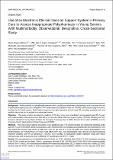Files in this item
Use of an electronic clinical decision support system in primary care to assess inappropriate polypharmacy in young seniors with multimorbidity : Observational, descriptive, cross-sectional study
Item metadata
| dc.contributor.author | MULTIPAP group | |
| dc.contributor.author | Aragon MultiPAP Group | |
| dc.contributor.author | Madrid MultiPAP Group: Marta Alcaraz-Borrajo | |
| dc.contributor.author | Lopez-Rodriguez, Juan A. | |
| dc.contributor.author | Sanz-Cuesta, Teresa | |
| dc.contributor.author | Aza-Pascual-Salcedo, Mercedes | |
| dc.contributor.author | Bujalance-Zafra, M. Jose | |
| dc.contributor.author | Cura-Gonzalez, Isabel | |
| dc.contributor.author | Hernández-Santiago, Virginia | |
| dc.contributor.author | Rico-Blázquez, Milagros | |
| dc.contributor.author | Tello-Bernabé, M. Eugenia | |
| dc.contributor.author | Rumayor-Zarzuelo, Mercedes | |
| dc.date.accessioned | 2021-03-25T12:30:12Z | |
| dc.date.available | 2021-03-25T12:30:12Z | |
| dc.date.issued | 2020-03-03 | |
| dc.identifier | 272337674 | |
| dc.identifier | d6b0a7e3-9d1f-41ba-a5f9-c8fba96b3085 | |
| dc.identifier | 85097112301 | |
| dc.identifier.citation | MULTIPAP group , Aragon MultiPAP Group , Madrid MultiPAP Group: Marta Alcaraz-Borrajo , Lopez-Rodriguez , J A , Sanz-Cuesta , T , Aza-Pascual-Salcedo , M , Bujalance-Zafra , M J , Cura-Gonzalez , I , Hernández-Santiago , V , Rico-Blázquez , M , Tello-Bernabé , M E & Rumayor-Zarzuelo , M 2020 , ' Use of an electronic clinical decision support system in primary care to assess inappropriate polypharmacy in young seniors with multimorbidity : Observational, descriptive, cross-sectional study ' , Journal of Medical Internet Research , vol. 8 , no. 3 , e14130 . https://doi.org/10.2196/14130 | en |
| dc.identifier.issn | 1439-4456 | |
| dc.identifier.other | ORCID: /0000-0002-8544-1483/work/86987228 | |
| dc.identifier.uri | https://hdl.handle.net/10023/21715 | |
| dc.description | This study was funded by National Institute for Health Research ISCIII (Grant numbers PI15/00276 (APT), PI15/00572 (ICG), PI15/00996 (JDPT), RD16/0001/0004 (ICG), RD16/0001/0005 (APT), RD16/0001/0006 (JDPT)) Co-funded by European Regional Development Fund, (ERDF) “A way of shaping Europe”. National Plan I+D+I 2013-2016. | en |
| dc.description.abstract | Background: Multimorbidity is a global health problem that is usually associated with polypharmacy, which increases the risk of potentially inappropriate prescribing (PIP). PIP entails higher hospitalization rates and mortality and increased usage of services provided by the health system. Tools exist to improve prescription practices and decrease PIP, including screening tools and explicit criteria that can be applied in an automated manner. Objective: This study aimed to describe the prevalence of PIP in primary care consultations among patients aged 65-75 years with multimorbidity and polypharmacy, detected by an electronic clinical decision support system (ECDSS) following the 2015 American Geriatrics Society Beers Criteria, the European Screening Tool of Older Person’s Prescription (STOPP), and the Screening Tool to Alert doctors to Right Treatment (START). Methods: This was an observational, descriptive, cross-sectional study. The sample included 593 community-dwelling adults aged 65-75 years (henceforth called young seniors), with multimorbidity (3 diseases) and polypharmacy (5 medications), who had visited their primary care doctor at least once over the last year at 1 of the 38 health care centers participating in the Multimorbidity and Polypharmacy in Primary Care (Multi-PAP) trial. Sociodemographic data, clinical and pharmacological treatment variables, and PIP, as detected by 1 ECDSS, were recorded. A multivariate logistic regression model with robust estimators was built to assess the factors affecting PIP according to the STOPP criteria. Results: PIP was detected in 57.0% (338/593; 95% CI 53-61) and 72.8% (432/593; 95% CI 69.3-76.4) of the patients according to the STOPP criteria and the Beers Criteria, respectively, whereas 42.8% (254/593; 95% CI 38.9-46.8) of the patients partially met the START criteria. The most frequently detected PIPs were benzodiazepines (BZD) intake for more than 4 weeks (217/593, 36.6%) using the STOPP version 2 and the prolonged use of proton pump inhibitors (269/593, 45.4%) using the 2015 Beers Criteria. Being a woman (odds ratio [OR] 1.43, 95% CI 1.01-2.01; P.04), taking a greater number of medicines (OR 1.25, 95%CI 1.14-1.37; P.04), working in the primary sector (OR 1.91, 95% CI 1.25-2.93; P.003), and being prescribed drugs for the central nervous system (OR 3.75, 95% CI 2.45-5.76; P<.001) were related to a higher frequency of PIP. Conclusions: There is a high prevalence of PIP in primary care as detected by an ECDSS in community-dwelling young seniors with comorbidity and polypharmacy. The specific PIP criteria defined by this study are consistent with the current literature. This ECDSS can be useful for supervising prescriptions in primary health care consultations. | |
| dc.format.extent | 10 | |
| dc.format.extent | 152981 | |
| dc.language.iso | eng | |
| dc.relation.ispartof | Journal of Medical Internet Research | en |
| dc.subject | Clinical decision support systems | en |
| dc.subject | Multimorbidity | en |
| dc.subject | Polypharmacy | en |
| dc.subject | Potentially inappropriate medication list | en |
| dc.subject | Primary care | en |
| dc.subject | RM Therapeutics. Pharmacology | en |
| dc.subject | Health Informatics | en |
| dc.subject | DAS | en |
| dc.subject.lcc | RM | en |
| dc.title | Use of an electronic clinical decision support system in primary care to assess inappropriate polypharmacy in young seniors with multimorbidity : Observational, descriptive, cross-sectional study | en |
| dc.type | Journal article | en |
| dc.contributor.institution | University of St Andrews. School of Medicine | en |
| dc.identifier.doi | https://doi.org/10.2196/14130 | |
| dc.description.status | Peer reviewed | en |
This item appears in the following Collection(s)
Items in the St Andrews Research Repository are protected by copyright, with all rights reserved, unless otherwise indicated.

